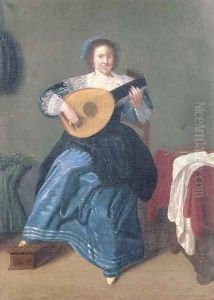Dirk Hals Paintings
Dirk Hals was a Dutch Golden Age painter, born in Haarlem in 1591. He was the younger brother of the more famous Frans Hals, who is often credited with revolutionizing portrait painting in the 17th century. Dirk, however, carved out his own niche in the art world, focusing primarily on genre scenes and merry company paintings, which depicted groups of people enjoying themselves in taverns or at parties. These scenes were popular in the Dutch Republic during a time of relative economic prosperity and political stability, reflecting the society's appreciation for the pleasures of life.
Dirk Hals was trained by his elder brother, Frans, and his style was influenced by the lively brushwork and keen observation of character that characterized Frans' work. However, Dirk's paintings are distinguished by their lighter, more humorous approach to subject matter, as well as their focus on group dynamics rather than individual portraiture. He was skilled in capturing the textures of luxurious fabrics and the interplay of light and shadow, creating scenes that were both vibrant and detailed.
Despite living in the shadow of his brother's fame, Dirk Hals made significant contributions to the genre of merry company paintings. He was an active member of the Haarlem Guild of St. Luke, a professional association for painters, which helped him secure commissions and foster connections within the art community. His works were sought after by wealthy patrons who appreciated his ability to depict the convivial spirit of the times.
Dirk Hals' paintings are characterized by a sense of spontaneity and joy. He often painted people engaged in conversation, playing music, or enjoying games, capturing the lively atmosphere of the Dutch Golden Age. His ability to depict light fabrics, such as lace and silk, with a high degree of realism was particularly admired. Despite his focus on leisure and entertainment, his compositions are carefully structured, with attention to balance and the flow of movement within the scene.
Dirk Hals died in Haarlem in 1656, leaving behind a body of work that, while not as widely recognized as that of his brother, provides valuable insight into the culture and society of his time. His paintings continue to be appreciated for their lively depiction of 17th-century Dutch social life, their technical skill, and their contribution to the development of the genre painting tradition in the Netherlands.
